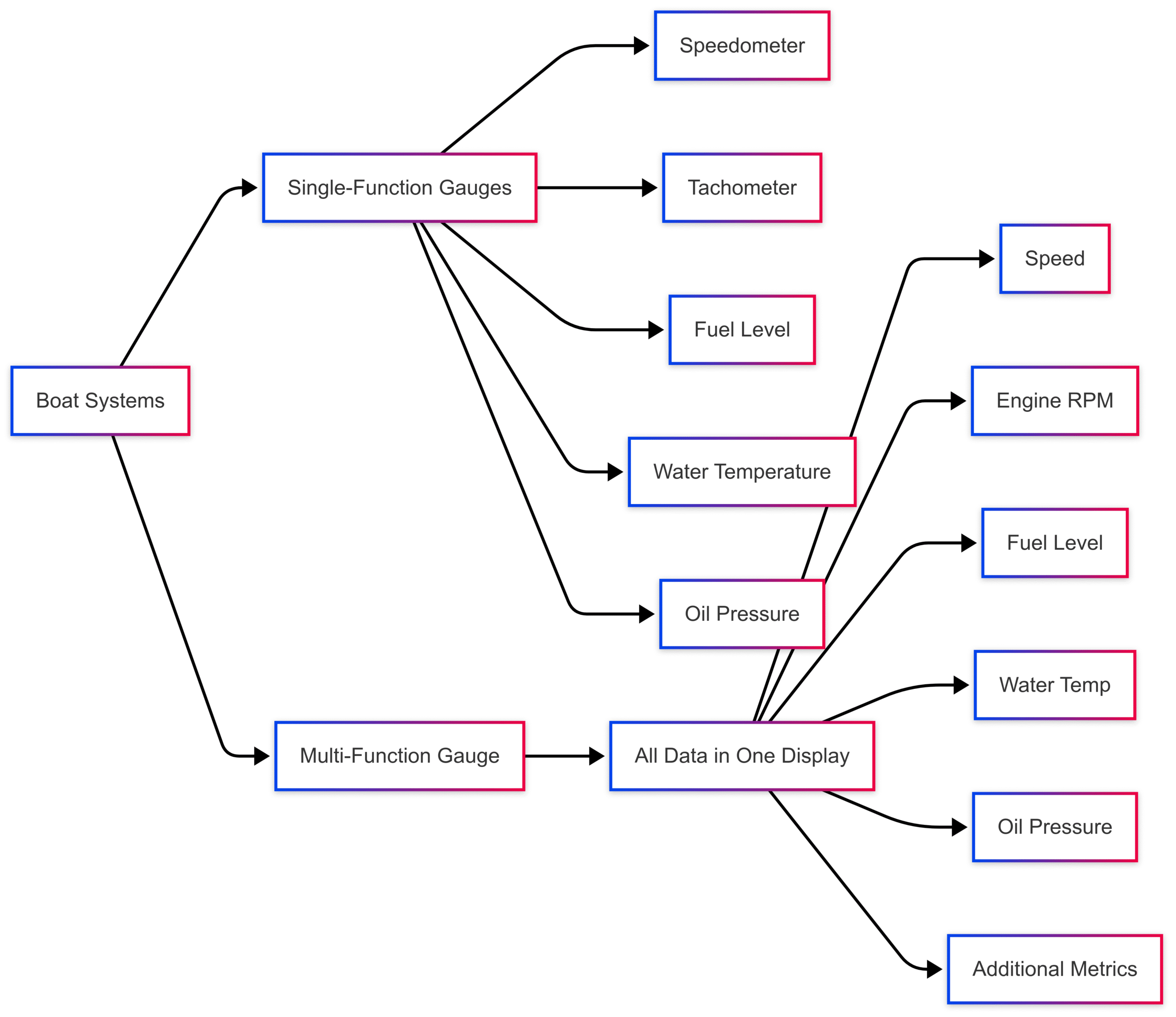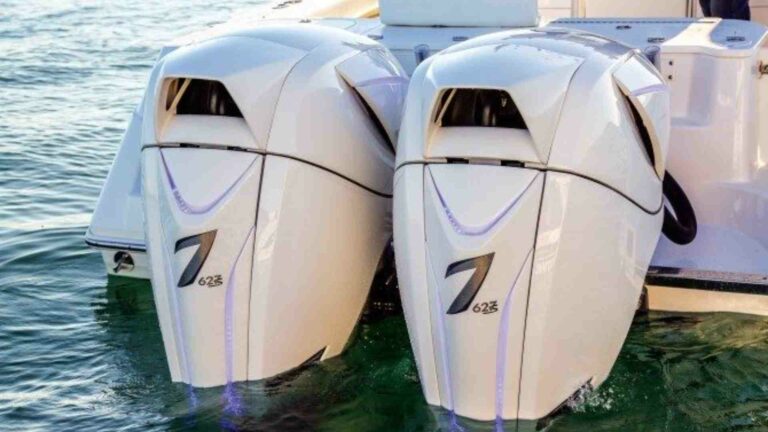4 Reasons to Consider a Marine Multi-Function Marine Gauges
Discover why marine multi-function gauges are essential for boaters. Streamline your dashboard, monitor vital data, and enhance efficiency on the water.
Marine multi-function gauges are revolutionizing the boating experience by consolidating critical vessel data into a single, user-friendly display. Whether you’re cruising an inland lake or navigating open waters, these advanced instruments simplify monitoring, enhance safety, and streamline your dashboard. This comprehensive guide explores the key reasons to consider marine multi-function gauges, their benefits, and how to choose the right one for your vessel, especially for a 35-foot boat used on an inland lake like Lake Lanier. We’ll also cover practical considerations like features, installation, troubleshooting, and budget, ensuring you have all the information needed to make an informed decision.
Understanding Marine Multi-Function Gauges
Marine multi-function gauges are sophisticated instruments that combine multiple data points—such as speed, engine RPM, fuel levels, oil pressure, and water temperature—into a single display. Unlike traditional single-function gauges, which require separate units for each metric, multi-function gauges (often called multifunction displays or MFDs) integrate these readings, reducing dashboard clutter and simplifying data management. Available in both analog and digital formats, these gauges cater to various boating preferences, from traditionalists who favor analog dials to tech-savvy boaters who prefer digital touchscreens.
For boaters on inland lakes, such as a 37,000-acre body like Lake Lanier, multi-function gauges offer tailored functionality for recreational cruising, ensuring you stay informed about your vessel’s performance without overwhelming complexity. They are particularly valuable for older boats (e.g., 25-year-old vessels) needing updated electronics, as they provide modern technology in a compact, efficient package.
Four Key Reasons to Choose Marine Multi-Function Gauges
1. Streamlined Dashboard for a Cleaner Look
One of the most immediate benefits of a multi-function gauge is its ability to declutter your boat’s dashboard. Traditional setups with individual gauges for speed, fuel, oil pressure, and other metrics can quickly overwhelm the helm, making it difficult to monitor critical data, especially in high-pressure situations. A single multi-function gauge consolidates these readings, freeing up space and creating a sleek, organized appearance.
For a 35-foot boat, dashboard space is often limited, and a cluttered helm can detract from the boating experience. By replacing four or more single-function gauges with one multi-function unit, you achieve a streamlined aesthetic that’s both functional and visually appealing. This is particularly beneficial for older vessels undergoing refits, where modernizing the cockpit with a clean, professional look is a priority.
Example: The Veethree multi-function gauge, available in styles like Black Sterling (black dial with stainless-steel bezel) or White Sterling (white dial with fire-orange pointer), enhances both functionality and elegance, blending seamlessly with other dashboard components.
2. Comprehensive Data in One Place
Marine multi-function gauges provide a holistic view of your vessel’s performance by displaying multiple metrics on a single screen or dial. Common readings include:
- Speedometer: Tracks vessel speed to ensure compliance with lake speed limits.
- Tachometer: Monitors engine RPM to detect potential mechanical issues.
- Fuel Level: Displays remaining fuel for efficient trip planning.
- Water Temperature: Tracks engine coolant temperature to prevent overheating.
- Oil Pressure: Monitors oil pressure to maintain engine health.
- Additional Metrics: Some gauges include voltage, trim angle, depth, or fuel flow for enhanced monitoring.
For inland lake boating, where safety and maintenance are paramount, having all this data in one place simplifies monitoring. For instance, on Lake Lanier, where recreational cruising is common, a multi-function gauge allows you to focus on enjoying the water rather than juggling multiple gauges. Advanced models, like the Suzuki SMG4, even integrate with smartphones or tablets for remote data access, offering real-time insights into engine performance and fuel economy.
Chart: Below is a flowchart illustrating how a multi-function gauge consolidates data compared to single-function gauges.

This chart highlights how a multi-function gauge centralizes data, reducing the need for multiple instruments and simplifying the boater’s workflow.
3. Simplified Installation and Troubleshooting
Installing multiple single-function gauges can be time-consuming and complex, requiring extensive wiring and calibration. In contrast, a multi-function gauge typically involves a single installation process, reducing both time and labor costs. This is especially advantageous for refitting a 25-year-old boat, where outdated wiring may need replacement. Most multi-function gauges are designed for plug-and-play compatibility with standards like NMEA 2000 or J1939, making integration with existing systems straightforward.
Troubleshooting is also easier with a single unit. If a gauge malfunctions, you only need to diagnose one device rather than multiple components. For example, loose connections or faulty sensors can be quickly identified and addressed, minimizing downtime. This is critical for inland lake boaters who rely on their vessels for weekend outings and want to avoid prolonged repairs.
Installation Steps:
- Choose a Location: Select an obstruction-free spot on the dashboard.
- Connect Wires: Attach power, ground, and signal wires to corresponding sensors.
- Connect Backlight: If equipped, wire the backlight for visibility.
- Mount the Gauge: Secure with a mounting bracket and screws.
- Test the System: Power on to verify functionality.
Troubleshooting Tips:
- Incorrect Readings: Check wiring connections or replace faulty sensors.
- No Response: Verify power supply connections.
- Spikes in Data: Tighten loose connections.
- Warning Signals: Inspect sensors for issues like short circuits.
4. Enhanced Visibility and Advanced Features
Modern multi-function gauges offer superior visibility and advanced features tailored to various boating conditions. Digital models, such as the Suzuki SMG4, feature 3.5-inch LCD screens with day and night modes to ensure readability in bright sunlight or low-light conditions. Analog versions, like the Veethree, use fog-resistant, scratch-resistant lenses and lit dials for clarity.
Additional features enhance functionality:
- Fuel Efficiency Monitoring: Tracks fuel flow to optimize consumption, ideal for long cruises on Lake Lanier.
- Trip Tracking: Logs distance and average speed for trip planning.
- Troll Mode: Allows precise RPM adjustments for trolling, though less relevant for non-fishing lake boaters.
- Customizable Displays: Switch between analog and digital modes to suit your preference.
These features ensure you have accurate, real-time data at your fingertips, enhancing safety and efficiency. For older boats, upgrading to a multi-function gauge brings modern technology without requiring a complete overhaul of the electrical system.
Analog vs. Digital: Which Is Right for You?
Choosing between analog and digital multi-function gauges depends on your preferences and boating style. Below is a detailed comparison to help you decide.
| Feature | Analog Multi-Function Gauge | Digital Multi-Function Gauge |
|---|---|---|
| Power Requirement | No external power needed, functional during outages | Requires power, may fail during outages |
| Readability | Easy-to-read dials with moving needles | Bright LCD with day/night modes, customizable displays |
| Change Detection | Moving needle highlights changes quickly | Real-time data with high precision |
| Durability | Mature technology, easy to repair | Fewer moving parts, potentially longer-lasting |
| Installation | Simple but may require multiple connections | Plug-and-play with NMEA 2000 or CANbus |
| Customization | Limited to physical dial design | Highly customizable via software |
| Cost | $100–$200 for basic models | $150–$500+ for advanced models |
Analog Gauges:
Preferred by traditionalists, analog gauges are reliable, power-independent, and easy to read at a glance. They’re ideal for inland lake boating, where simplicity and durability are key. The Veethree multi-function gauge, for example, offers a classic look with modern features like fog-resistant lenses.
Digital Gauges:
Favored by tech-savvy boaters, digital gauges provide precision, real-time data, and integration with smart devices. They’re perfect for those who want a modern, high-tech cockpit. The Suzuki SMG4, with its touch-controlled troll mode and smartphone connectivity, exemplifies digital innovation.
For a 25-year-old 35-foot boat on Lake Lanier, a hybrid approach might work best. A custom gauge combining analog and digital inputs (via CANbus and traditional sensors) can bridge old and new systems, ensuring compatibility and functionality.
Key Features for Inland Lake Boating
For recreational cruising on an inland lake like Lake Lanier, your multi-function gauge should prioritize the following features:
- Essential Metrics: Speed, fuel level, engine RPM, water temperature, and oil pressure are critical for safety and maintenance.
- Depth Sounder: Lake Lanier’s variable depths require a depth sounder to avoid grounding.
- GPS/Chartplotter: A basic chartplotter (e.g., Garmin GPSMAP 943xsv, ~$1,500) ensures accurate navigation, though a GPS-enabled tablet with Navionics (~$50/year subscription) is a budget-friendly alternative.
- VHF Radio: A mounted VHF with GPS ($250–$350) and antenna ($100) is essential for emergency communication.
- Marine Stereo: A quality stereo system (~$500) enhances the cruising experience.
- NMEA 2000 Compatibility: Ensures integration with engine data and other electronics (may require a $500 gateway for older engines).
Optional Features:
- Radar: Useful for larger lakes with fog or heavy traffic but not mandatory for fair-weather cruising (~$3,000).
- Troll Mode: Less relevant for non-fishing activities.
- EPIRB: Not necessary for inland lakes with reliable cell service.
Budgeting for Your Multi-Function Gauge Setup
For a 35-foot boat on Lake Lanier, a realistic budget for updating electronics depends on your priorities. Below is a breakdown of costs for a functional, no-frills setup versus a premium setup with additional features.
| Component | Basic Setup ($4,000–$5,000) | Premium Setup ($8,000–$10,000) |
|---|---|---|
| Multi-Function Gauge/MFD | $1,500 (e.g., Garmin GPSMAP 943xsv) | $3,000 (e.g., Garmin GPSMAP 1243xsv) |
| VHF Radio + Antenna | $350 (mounted VHF with GPS) | $500 (advanced VHF with AIS) |
| NMEA 2000 Backbone | $100 | $100 |
| Engine Gateway | $500 (for older engines) | $500 |
| Marine Stereo/Speakers | $500 | $1,000 (premium audio system) |
| Depth Transducer | $200 | $300 (high-performance transducer) |
| Radar | N/A | $3,000 (e.g., Garmin GMR 18 HD+) |
| Installation Costs | $1,000 (DIY or basic labor) | $1,500 (professional installation) |
Total Estimated Cost:
- Basic Setup: ~$4,150
- Premium Setup: ~$9,900
Budget Tips:
- Opt for a single MFD like the Garmin GPSMAP 943xsv to cover chartplotting, sonar, and engine data.
- Use a GPS-enabled tablet with Navionics for cost-effective navigation (~$50/year vs. $1,500 for a dedicated chartplotter).
- Prioritize NMEA 2000-compatible gauges for future-proofing and easy integration.
- Consider DIY installation to save on labor costs, as multi-function gauges are designed for straightforward setup.
Top Brands and Models
Several brands offer reliable multi-function gauges suitable for inland lake boating. Below are some top options with their specifications and price ranges:
Garmin GPSMAP 943xsv
The Garmin GPSMAP 943xsv is a premium 9-inch touchscreen marine display that integrates chartplotting, sonar, and NMEA 2000 networking. It’s perfect for boaters seeking advanced navigation tools with a sleek interface and the option to expand with radar for enhanced situational awareness.
| Specification | Details |
|---|---|
| Model | Garmin GPSMAP 943xsv |
| Price | $1,500 |
| Display | 9-inch touchscreen Multi-Function Display (MFD) |
| Features | Chartplotter, sonar capabilities, and NMEA 2000 network support |
| Radar Compatibility | Optional radar support available |
| Best For | User-friendly marine navigation and engine monitoring |
Suzuki SMG4
The Suzuki SMG4 is a compact, multifunctional engine gauge designed for Suzuki outboard motors. Featuring a 3.5-inch LCD screen with both analog and digital modes, it provides real-time data on RPM, speed, fuel flow, and trim angle. It also includes a user-friendly touch-controlled troll mode and smartphone integration, making it a modern and efficient tool for marine enthusiasts.
| Specification | Details |
|---|---|
| Model | Suzuki SMG4 |
| Price Range | $400–$600 |
| Display | 3.5-inch LCD with analog/digital modes |
| Displayed Information | RPM, speed, fuel flow, trim angle |
| Troll Mode | Touch-controlled for precise low-speed maneuvering |
| Smartphone Integration | Allows connectivity with mobile devices for enhanced data monitoring |
Veethree Multi-Function Gauge
A durable, stylish, and versatile analog gauge ideal for marine and vehicle applications, offering clear readings and customizable monitoring for multiple engine parameters.
| Specification | Details |
|---|---|
| Product Name | Veethree Multi-Function Gauge |
| Price Range | $150–$300 |
| Display Type | Analog display with fog-resistant, scratch-resistant lenses |
| Functionality | Customizable to monitor fuel, oil, temperature, and voltage |
| Design Options | Available in Black Sterling, White Sterling, and Argent finishes |
| Fuel Tank Depth Range | Compatible with tanks 7–24 inches deep |
Faria Beede Chesapeake
A versatile marine gauge available in both analog and digital formats. Built with a stainless-steel bezel and IP67 rating, it’s durable enough for marine environments. Compatible with industry-standard data networks like J1939 and NMEA 2000, ideal for modern boat systems.
| Feature | Details |
|---|---|
| Item Name | Faria Beede Chesapeake |
| Price Range | $200–$400 |
| Display Type | Analog and digital options |
| Build Quality | Stainless-steel bezel |
| Durability Rating | IP67-rated (waterproof and dust-resistant) |
| Compatibility | Supports J1939 and NMEA 2000 protocols |
Lowrance HDS-7 LIVE
The Lowrance HDS-7 LIVE is a compact yet powerful marine display unit that combines a chartplotter and sonar, making it an excellent choice for small vessels. It supports NMEA 2000 networking and offers a cost-effective solution for anglers and boaters seeking advanced navigation and fish-finding capabilities in a space-saving format.
| Item | Details |
|---|---|
| Product Name | Lowrance HDS-7 LIVE |
| Price | $1,200 |
| Display | 7-inch MFD (Multifunction Display) with chartplotter and sonar |
| Connectivity | NMEA 2000 support |
| Ideal Use | Budget-friendly option suitable for smaller dashboards |
When choosing a brand, visit retailers like West Marine or Bass Pro Shops to test displays and ensure they fit your dashboard’s size and aesthetic. For older boats, verify engine compatibility (e.g., NMEA 2000 or analog senders) and consider a gateway for legacy systems.
Installation and Maintenance Best Practices
Installation:
- Plan Wiring Carefully: Ensure compatibility with existing sensors and networks (e.g., NMEA 2000).
- Secure Mounting: Use corrosion-resistant brackets to withstand lake conditions.
- Test Thoroughly: Verify all data inputs (speed, fuel, etc.) display correctly before finalizing.
Maintenance:
- Regular Inspections: Check wiring and connections for corrosion or wear.
- Clean Displays: Use non-abrasive cleaners to maintain screen clarity.
- Monitor Performance: Replace gauges showing signs of rust, cracks, or water damage.
Durability Considerations:
- Look for IP67-rated gauges to resist dust and water immersion.
- Choose models with anti-fog lenses and corrosion-resistant materials (e.g., stainless steel or brass).
Custom Gauges for a Tailored Experience
For unique needs, custom multi-function gauges offer a tailored solution. Companies like Bamboo Apps can develop hybrid gauges that integrate analog and digital inputs, matching your boat’s aesthetic and functionality. For example, a custom gauge using the iQAN platform can display data via a modern GUI, supporting CANbus and traditional sensors. These solutions are ideal for refitting older vessels, ensuring compatibility with legacy systems while adding modern flair.
Comparison: iQAN vs. Android for Custom Gauges
| Feature | iQAN Platform | Android Platform |
|---|---|---|
| Hardware | Proprietary (Parker Hannifin) | Open-source, widely compatible |
| Customization | Limited to manufacturer’s ecosystem | Highly flexible, supports diverse displays |
| Cost | Higher due to proprietary design | Lower, leverages existing hardware |
| Ease of Use | Intuitive GUI, brand-specific | Familiar interface, broader app support |
| Compatibility | Best for Parker hardware | Universal, ideal for mixed systems |
For a 25-year-old boat, an Android-based custom gauge may be more cost-effective and versatile, especially if you’re integrating with older analog sensors.
Addressing Common Concerns
Are multi-function gauges easy to install?
How do I maintain my gauge?
When should I replace my gauge?
Risks of All-in-One Units:
While multi-function gauges consolidate data, a single unit failure could disrupt all readings. To mitigate this, choose reliable brands (e.g., Garmin, Suzuki) and maintain a backup GPS-enabled tablet for navigation.
Conclusion
Marine multi-function gauges are a must-have for boaters seeking efficiency, safety, and a modernized cockpit. For a 35-foot boat on Lake Lanier, they offer a streamlined solution to monitor speed, fuel, engine performance, and depth, all while reducing dashboard clutter. With a budget of $4,000–$10,000, you can equip your vessel with a reliable MFD, VHF radio, and stereo, tailored to recreational cruising. Brands like Garmin, Suzuki, and Veethree provide durable, user-friendly options, while custom gauges offer personalized solutions for older boats. By investing in a multi-function gauge, you’ll enhance your boating experience, ensuring smooth, informed, and enjoyable trips on the water.
Happy Boating!
Share 4 Reasons to Consider a Marine Multi-Function Marine Gauges with your friends and leave a comment below with your thoughts.
Read How to Catch More Fish with Side-Imaging Technology until we meet in the next article.






